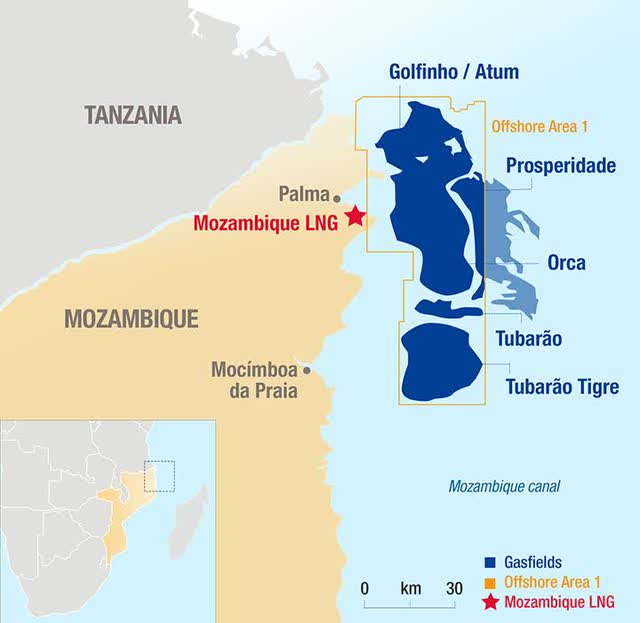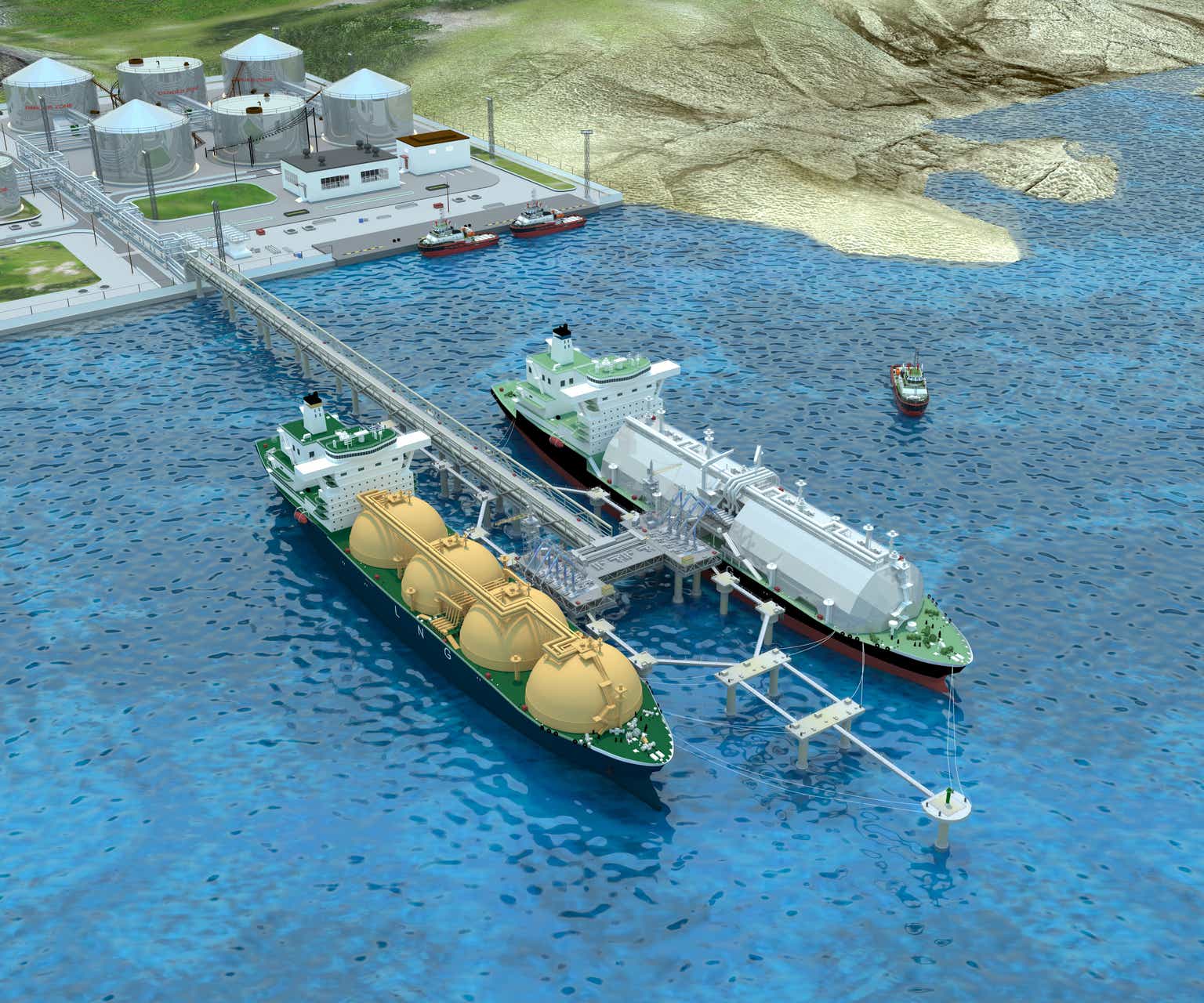Following up on my article covering Tanzania’s emerging liquefied natural gas [‘LNG’] export industry, East African Energy Bonanza Sees Tanzania Enter LNG Export Space (link here), I’m going to cover Mozambique’s emerging LNG industry in this article. East Africa is experiencing an energy bonanza that investors interested in the energy sector should pay close attention to. Vast amounts of natural gas reserves have been discovered off the coast of East Africa and regional demand relative to the size of these resources is rather small, which means that LNG export terminals are needed to commercialize these exploration successes. Demand for external sources of natural gas in Europe and East Asia creates an environment favorable for LNG exporters with access to vast reserves.
France Enters the Fray Alongside Numerous Partners
France’s state-run energy firm, TotalEnergies SE (TTE), is the operator of the Mozambique LNG project and owns a 26.5% stake in the venture. Back in September 2019, TotalEnergies acquired then-Anadarko Petroleum’s stake in the venture back for $3.9 billion as part of Occidental Petroleum Corporation’s (OXY) enormous ~$57 billion deal to acquire Anadarko. This was part of a bigger deal between Anadarko, Occidental and TotalEnergies that involved TotalEnergies acquiring Anadarko’s position in Algeria, Ghana, South Africa, and Mozambique for $8.8 billion in the event that Occidental’s purchase of Anadarko went through, which it did.
Around 65 trillion cubic feet of natural gas, equal to 12 billion barrels of oil equivalent, has been discovered in the Offshore Area 1 concession (also referred to as the Rovuma Area concession as its located in the Rovuma Basin) which is now operated by TotalEnergies. Exploration and appraisal activities testing the Prosperidade and Golfinho/Atum complexes have determined that production wells could be developed in this concession with peak production rates of 100-200 million cubic feet of natural gas per day. Initial wells produced around 90-100 million feet of natural gas per day on a facility-constrained basis. Production wells that are designed to support higher output levels could achieve similar or higher production rates.
The consortium developing the endeavor includes TotalEnergies with its aforementioned 26.5% stake, the Japanese conglomerate Mitsui & Co Ltd (OTCPK:MITSF) with a 20% stake, Empresa Nacional de Hidrocarbonetos (abbreviated as ENH, this is Mozambique’s national oil and gas company) with a 15% stake, and PTTEP (Thailand’s national oil and gas company) with a 8.5% stake. Additionally, there are several Indian firms invested in the endeavor, including the state-run firm Bharat Petroleum Corporation with a 10% stake, state-run ONGC Videsh (a wholly-owned subsidiary of Oil and Natural Gas Corporation, another Indian national oil and gas company) which has a direct 10% stake in the venture and owns a 60% interest in Beas Rovuma Energy Mozambique Limited which in turn owns 10% of the Mozambique LNG venture. The other 40% of Beas Rovuma Energy Mozambique Limited is owned by Oil India.
Development Overview
As you can see, the backers of the Mozambique LNG export project are energy majors based in France, Japan, Thailand, and India, countries that are large oil and gas importers. In June 2019, a final investment decision was made to move forward with the Mozambique LNG export project.
A map of the Mozambique LNG project. (TotalEnergies – September 2019 Press Release)
Developing the Golfinho and Atum natural gas fields in the Offshore Area 1 concession will enable the consortium to feed two LNG liquefaction trains that are being constructed along the coast of Mozambique in the northern part of the country. These two LNG trains will have the capacity to ship out 12.9 million metric tons of LNG per year and this phase of the development is targeting 18 trillion cubic feet of natural gas resources.
Should market conditions warrant it, future developments could develop the remaining resources in the concession. As ~90% of the LNG export venture’s capacity has already been sold under long-term contracts, primarily to buyers in Europe and Asia, the future cash flows of this asset have been secured. Furthermore, the project has a domestic component which will supply natural gas to customers in Mozambique via new and existing distribution networks.
Hurdles Stymie Development Though Positive Signs are Now Emerging
However, the venture ran into some problems as the security situation in the Cabo Delgado province, Mozambique’s northernmost province, continued to deteriorate in the following years after an insurrection sprung up in 2017. In April 2021, TotalEnergies declared force majeure and evacuated all of its personnel from the development after insurgents attacked the town of Palma near the project. Due to several African nations intervening in the Cabo Delgado province in conjunction with Mozambique’s armed forces, construction may soon resume (which is what Mozambique’s government wants) though TotalEnergies has yet to resume development activities.
Originally, the Mozambique LNG project was expected to cost roughly $20 billion to develop with the first LNG cargo expected to ship out in 2024. Now that price tag has likely gone up and it will take a while longer for the project to become operational and ship out its first LNG cargo. However, things are improving on the ground.
The nation’s president, Filipe Nyusi, noted in April 2023 that construction should resume on the project and TotalEnergies’ CEO and Chairman, Patrick Pouyanne, met Mozambique’s president earlier this year to talk about the security situation and the Mozambique LNG project. Mozambique wants to benefit from the export revenues, tax revenues, economic activity, and added domestic natural gas supplies that the LNG export project would generate, and the consortium developing the project wants to finish what they started.
Concluding Thoughts
As the East African energy bonanza is now well underway, investors interested in the energy sector should take notice. These LNG supplies will compete for market share against supplies from the US, though there is room for multiple winners here as Western-aligned nations are shunning Russian energy in the wake of Russia’s invasion of Ukraine in February 2022. The United States Natural Gas Fund LP (UNG), Energy Select Sector SPDR Fund (XLE), and the SPDR S&P Oil & Gas Exploration & Production ETF (XOP), and VanEck Africa Index ETF (AFK) are relevant tickers to keep an eye on as it concerns East Africa’s emerging LNG export industry.
It isn’t clear when construction activities at the Mozambique LNG export development will resume and how the delay will impact the development timetable. What is clear is that Mozambique is sitting on vast natural gas resources that will soon get connected with major buyers in Europe and Asia. Farther out, there is ample room for future development phases given that the first phase is only targeting a slice of the total natural gas resources in place. I’m keeping an eye on this venture.
Editor’s Note: This article discusses one or more securities that do not trade on a major U.S. exchange. Please be aware of the risks associated with these stocks.
Read the full article here







